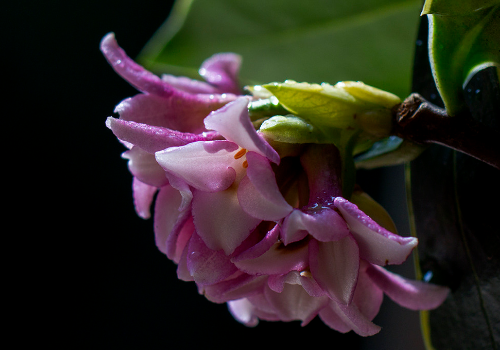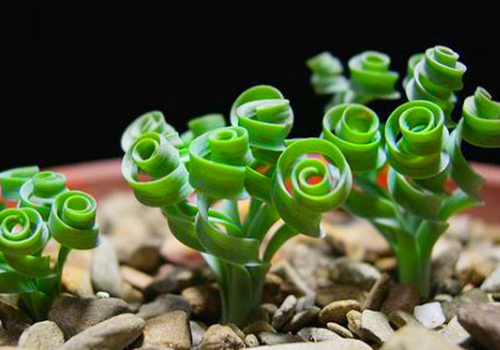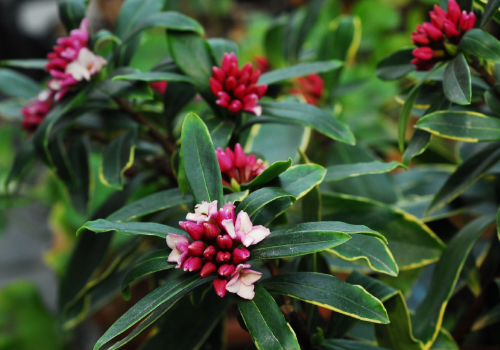Can Phnom Penh Daphne be cultured in water? how to cultivate in water?
As a well-known traditional flower plant in China, Phnom Penh Daphne has always been loved by people. Can Phnom Penh Daphne be hydroponically cultivated? How to cultivate in water:
Can Phnom Penh Daphne be hydroponically cultured?
Although hydroponic culture is a very popular way of potted plants at present, it is not only easy to operate, but also beautiful and clean. Phnom Penh Daphne can also be maintained by hydroponics, which can take root quickly and have a high survival rate. But one drawback of hydroponics is that it is difficult to blossom.

How does Phnom Penh incense grow in water:
1. Material selection
Choose the vessel that puts the branch, the space had better be bigger, oxygen is sufficient, it is advantageous to take root. If you want long-term hydroponics, you can prepare a beautiful glass container, which can be placed and watched after taking root.
2. Branch selection
Choose the sturdy semi-lignified branches of the current year (the branches are a little green), cut 6-8 cm in length, and retain 1-2 leaves. The day before the branch is cut, a sharp knife can be used to make a circle around the incision to speed up the wound healing.
3. Determine the time
The hydroponic culture of Phnom Penh Daphne can be carried out all the year round, but the highest survival rate is in summer. The best time is in Shandong in late July and in the south in early July. Because at this time the branches tend to mature and take root more quickly.
4. Operation method
First, split the lower end of the branch in the middle and separate the two halves with pebbles. Then soak the branches in disinfectant for about 10 minutes, then disinfect them and take them out. According to the thickness of the branch, insert several small holes in the plastic board and insert the branch into it, exposing about 3-4 cm at the lower end of the branch. Then put the plastic foam in a container full of water, and the bottom of the branch should touch the surface of the water and put it in the sunrise indoors.
5. Maintenance
Change water every 2-3 days, spring water, river water is best, or tap water stored for a few days. When changing water, moss may appear around the utensils, which should be cleaned and disinfected with potassium permanganate solution at the same time. If you encounter hot and dry weather, add water to the container and sprinkle water to the ground in time. Generally, under the condition of 22-28 ℃, it can take root in about 50 days.
Now many plants can be hydroponized, and Phnom Penh Daphne can also be hydroponized.
Hydroponic culture method of Daphne odorifera in Phnom Penh
Water culture Jinbian Daphne: material selection
Before hydroponics, you should first choose utensils that can put branches. The space had better be bigger, and there is enough oxygen, which is conducive to rooting.
In addition, if you want long-term hydroponics, you can prepare a beautiful glass container, which can be placed and watched after taking root.
Plastic foam board, clean pebbles, loose soil.
Hydroponic Phnom Penh Daphne: branch selection
Choose the sturdy semi-lignified branches of the current year (the branches are a little green), cut the length of 6 cm to 8 cm, and retain 1 to 2 leaves. The day before the branch is cut, a sharp knife can be used to make a circle around the incision to speed up the wound healing.
Hydroponic Phnom Penh Daphne: determine the time
The hydroponic culture of Phnom Penh Daphne can be carried out all the year round, but the highest survival rate is in summer. The best time is in Shandong in late July and in the south in early July. Because at this time the branches tend to mature and take root more quickly.
Hydroponic Phnom Penh Daphne: operation method
First, split the lower end of the branch in the middle and separate the two halves with pebbles.
Then soak the branches in disinfectant for about 10 minutes, then disinfect them and take them out.
According to the thickness of the branches, insert several small holes in the plastic board and insert the branches into them, exposing about 3 to 4 centimeters at the bottom of the branches.
Then put the plastic foam in a container full of water, and the bottom of the branch should touch the surface of the water and put it in the sunrise indoors.
Water culture Jinbian Daphne: conservation
Change the water every 3 days, spring water, river water is the best, or tap water stored for a few days. When changing water, moss may appear around the utensils, which should be cleaned and disinfected with potassium permanganate solution at the same time.
If you encounter hot and dry weather, add water to the container and sprinkle water to the ground in time. Generally, under the condition of 22-28 ℃, it can take root in about 50 days.
Introduction to the hydroponic culture method of Phnom Penh Daphne odora and its maintenance after hydroponics
For Phnom Penh Ruixiang, we should be no stranger to it! Phnom Penh Daphne is a traditional Chinese flower with a yellowish edge and green in the middle. When it blossoms, Phnom Penh Daphne is the most beautiful, with flowers in clusters, giving off a delicate fragrance. Today, I'll take you to learn about the hydroponic culture of Daphne odora in Phnom Penh.
1. Material selection
Before hydroponics, you should first choose utensils that can put branches. The space had better be bigger, and there is enough oxygen, which is conducive to rooting. In addition, if you want long-term hydroponics, you can prepare a beautiful glass container, which can be placed and watched after taking root. Plastic foam board, clean pebbles, loose soil.
2. Branch selection
Choose the sturdy semi-lignified branches of the current year (the branches are a little green), cut the length of 6 cm to 8 cm, and retain 1 to 2 leaves. The day before the branch is cut, a sharp knife can be used to make a circle around the incision to speed up the wound healing.
3. Determine the time
The hydroponic culture of Phnom Penh Daphne can be carried out all the year round, but the highest survival rate is in summer. The best time is in Shandong in late July and in the south in early July. Because at this time the branches tend to mature and take root more quickly.
4. Operation method
First, split the lower end of the branch in the middle and separate the two halves with pebbles.
Then soak the branches in disinfectant for about 10 minutes, then disinfect them and take them out.
According to the thickness of the branches, insert several small holes in the plastic board and insert the branches into them, exposing about 3 to 4 centimeters at the bottom of the branches.
Then put the plastic foam in a container full of water, and the bottom of the branch should touch the surface of the water and put it in the sunrise indoors.
5. Maintenance methods
(1) change the water every 2-3 days, spring water and river water are the best, or tap water stored for a few days. When changing water, moss may appear around the utensils, which should be cleaned and disinfected with potassium permanganate solution at the same time.
(2) if the weather is relatively hot and dry, add water to the container and sprinkle water to the ground in time. Generally, under the condition of 22-28 ℃, it can take root in about 50 days.
The above is my arrangement of Phnom Penh Ruixiang hydroponic method, hope to be helpful to the majority of flower friends, but also please continue to pay attention to succulent flower beds, learn more about flower conservation.
- Prev

When does the spring grass bloom and die?
Spring grass is a very interesting plant. It completes its very unique shape by twisting its leaves. When does spring grass bloom? When will the flowers bloom? When will the spring grass bloom? The flowering of the spring grass is in February of each year.
- Next

How to maintain after growing flowers in Phnom Penh Ruixiang in winter
Phnom Penh incense blossoms every spring and usually blossoms only once. How to raise Ruixiang in Phnom Penh in winter? How to maintain after flowering: how to raise Daphne odora in winter in Phnom Penh: move indoors, the safe overwintering temperature of Daphne odora in Phnom Penh is above 5 ℃, so you can put it in the south window to receive sunlight during the day.
Related
- Fuxing push coffee new agricultural production and marketing class: lack of small-scale processing plants
- Jujube rice field leisure farm deep ploughing Yilan for five years to create a space for organic food and play
- Nongyu Farm-A trial of organic papaya for brave women with advanced technology
- Four points for attention in the prevention and control of diseases and insect pests of edible fungi
- How to add nutrient solution to Edible Fungi
- Is there any good way to control edible fungus mites?
- Open Inoculation Technology of Edible Fungi
- Is there any clever way to use fertilizer for edible fungus in winter?
- What agents are used to kill the pathogens of edible fungi in the mushroom shed?
- Rapid drying of Edible Fungi

